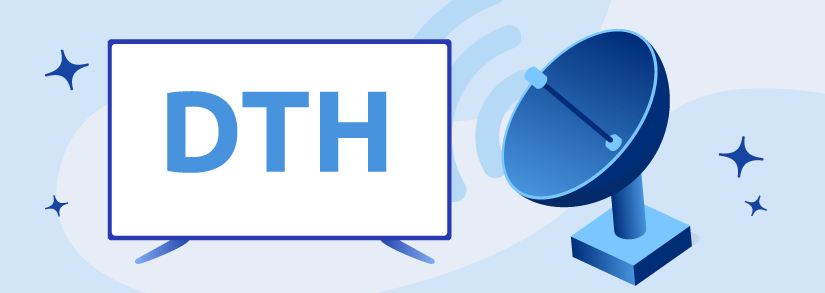Everything To Know About DTH Technology & How It Works

DTH Technology, also known as Direct To Home Technology, has risen to prominence in the television broadcasting sector during the previous decade. The satellite television transmission procedure that is meant for home reception is known as direct-to-home technology. This technique was previously known as the direct broadcast satellite (DBS) technique.
In this article, we will go over what DTH technology is, how it works, and why it is the future of cable TV, especially in India.
The visual and sound quality is improved with Direct to Home Technology. It also provides an internet connection, video conferencing, and email services.
What is DTH Technology
Direct-To-House (DTH) system is a digital satellite service that delivers television services directly to your home through a personal dish. Local cable companies are not necessary with DTH, which connects the broadcaster directly to the customer.
Direct to Home Technology improves image and audio quality. It also provides an internet connection, video calls, and email. This technology's increased features include HDTV (High Definition TV) and 3D TV. It also allows you to record, rewind, and stop live television.
The Rise of DTH In India
In India, DTH services were initially proposed in 1996. However, they were not approved due to worries about national safety and cultural incursion. When Rupert Murdoch's Indian Sky Broadcasting (ISkyB) was preparing to begin its DTH services in India in 1997, the authorities even placed a ban.
DTH was finally permitted in 2000. According to the new rules, all operators must establish earth stations in India within 12 months after receiving a license. In India, DTH permits will cost $2.14 million and will be good for ten years. Companies providing DTH services would be required to have an Indian CEO, and foreign shareholding would be limited to 49%. The number of firms that can apply for a DTH license is not limited.
Some of the most popular DTH providers in India are as follows:
How Does DTH Work?
A DTH network is made up of several components, including a broadcasting centre, satellites, encoders, multiplexers, modulators, and DTH receivers.
The satellite needs to lease Ku-band transponders to a DTH network operator. The encoder transforms audio, video, as well as data signals to digital format, while the multiplexer combines them. A tiny dish antenna plus set-top boxes will be available to users in order to decode and see a variety of channels. Receiving dishes might be as tiny as 45 cm in diameter for the user.
DTH is an encrypted broadcast that flows straight to the customer through a satellite. DTH transmissions are received directly by the customer via the tiny dish antenna. Unlike a typical cable connection, a set-top box decrypts the encrypted signal.
Elements of DTH Technology
There are 7 major elements required for a DTH network to send and receive data:
1) Broadcasting Centre
The Broadcast Centre serves as the system's principal centre. The television provider gets signals from numerous content sources and afterwards sends a broadcast signal to Geostationary orbit satellites. The transmissions from the broadcasting station are received by the satellites and relayed to the earth.
2) Encryption Transmission
After the video has been compressed, the provider must encrypt it to prevent it from being obtained for free. Encryption rearranges digital data in such a manner that it could only be decrypted (transformed back into usable data) if the receiver is equipped with the appropriate decoding satellite receiver, decryption algorithm, as well as security keys.
The broadcast center shoots the signal straight to its satellites once it has been compressed and encrypted. The satellite detects the signal, magnifies it, and sends it back to Earth, where it could be received by the customer.
3) The Satellite Dish
A satellite dish is a kind of an antenna that is specifically intended to focus on a single broadcast source. The typical dish has a bowl-shaped (parabolic) surface with a centred feed horn. The signal is sent through the horn by a controller. The dish concentrates the signal into a pretty small beam in order to transmit it.
The receiving dish cannot transfer the information; it could only receive it. The receiving dish operates in an inverse manner as the sending end. When a beam strikes the curved dish, the bowl shape returns the radio signal inwards onto a specific spot, similar to how a concave mirror concentrates light on a specific spot.
The curved dish directs incoming radio signals toward the feed horn. The point in this scenario is the dish's feed horn, which sends the signal to the receiving device. There should be no substantial obstructions between the satellite and the dish in an ideal arrangement so that the dish gets a clean signal.
4) Multiplexer
A multiplexer is a device that sends information from many channels in a single channel. It is a component of the broadcasting facility. The Multiplexer at the Broadcasting Centre combines all frequency signals together into a single channel and delivers it to the Geo-Stationary satellite. It sends the Modulator a single channel.
5) Modulator
Modulation is a method in which an information signal is superimposed on a strong carrier signal. The signals are modulated and sent to the Encoder by the Modulator.
6) Encoder
The Encoder encrypts the signals before transmitting them. The signals are sent from the satellite to the DTH Antenna, which then delivers them to the Set-Top Box.
7) The Receiver
The receiver is the last element in the complete satellite DTH system. The receiver performs four critical functions:
- It decrypts or de-scrambles the encoded signal. To decrypt the signal, the appropriate decoder chip for that encoding package is required. The supplier can connect with the chip through the satellite signal in order to make necessary changes to its decoding routines. As an electronic countermeasure (ECM) against unauthorized users, the provider may broadcast signals that distort illicit de-scramblers on occurrence.
- It transforms the digital MPEG-2 stream into an analog format that a typical television can readily identify. You can't tape one show while watching another since the receiver only outputs one channel at a time. You likewise can't view two distinct shows on two different TVs that are both connected to the same receiver. To accomplish these things, which are ordinary conventional cable, you will need to purchase an extra receiver.
Parental Lock, Pre-booked Pay-Per-View, and Impulse Pay-Per-View are some of the applications available through Direct to Home Technology.
Benefits of DTH Technology
The major benefit is that this technology benefits everyone uniformly. Because the procedure is wireless, this structure can be used in any location, whether secluded or urban. In addition to this, mentioned below are some of the prominent benefits of DTH technology.
- There are no intermediaries, high-quality audio and video are inexpensive.
- Approximately 4000 channels, as well as 2000 radio channels, could be seen. As a result, you have access to all of the world's information, especially news and entertainment, from the comfort of your own home.
- There are no middlemen, a complaint may be addressed directly to the supplier.
- You would be able to utilise digital quality audio, video, as well as high-speed Internet with a single DTH service.
What Should You Get: DTH or Cable TV?
In India, there have been 2 kinds of TV connections available: Direct-to-Home (DTH) plus cable TV. Both can give you fascinating material and your favourite channels, but they are vastly different. So, which one should you get?
Broadcasting Technology
The Local cable operators transmit the television signals from the receiving office to the cable subscriber’s home through coaxial cable. While DTH is a concern they directly transmit the received signals directly to the subscribers through a dish installed on a roof of the DTH subscribers.
Picture Quality
DTH's picture quality is far superior to that of cable operators. The primary cause is because the cable operator utilized coaxial cable for several kilometres from their location to the real user implies cable customers, resulting in distorted picture quality. When it comes to DTH, a little cable is utilized to connect the setup box to the dish mounted on the customers' terrace.
Cost-effectiveness
If money is an issue, cable providers are more cost-effective than DTH. The cable connection involves the bulk of the channels. While DTH can become more package-oriented to meet the needs of customers. As a consequence, it is more costly than cable television.
Flexibility
DTH gives consumers additional options in terms of how many channels they want to watch or not. It will give clients personalized service. Local cable operators, on the other hand, are unable to restrict the number of channels. If a consumer requests the addition of a specific channel of interest, the cable operator may refuse to offer it.
Weather Impact
When the climate is bad, particularly throughout the rainy season, the DTH has signal problems. The broadcasting is stopped due to fading in heavy rain and hazy weather conditions. The cable operator has a significant benefit in that they do not have to deal with network outages.
Portability
DTH is more convenient in terms of portability because the same firms, such as Dish TV, Tata Sky, Videocon D2H, Sun Direct, and others, are present all through the nation. People who move to a different city or area can take their satellite dish antenna and STB with them and have it installed at the new site.
This is not feasible with cable companies since each part of the city is served by a separate cable company. There is no interconnection between cable carriers offering service in various sections of respective cities, even between cities.
Advanced Features
The DTH subscribers enjoy much more advanced features and services such as Video on Demand, Interactive Tv. On the other side, the Cable operator is getting the advantage of these features. So, compared to Cable operators the DTH providers a better facility of the good all-round viewing experience.
Maintenance and Service
In comparison to DTH, when a customer has a service difficulty due to a technical malfunction, the local cable company can resolve it in a timely manner. Every user may anticipate the problem to be resolved quickly. In the situation of DTH, the servicing process includes two to three workdays for a professional to reach the location and is also costly.
Monopoly
There are various firms that offer DTH services, which might benefit customers by giving them options. If a consumer is dissatisfied with a DTH provider, he or she can change to another provider. The cable operator is an issue because there's only one cable operator for a specific area or city.
They are not authorized to enter different geographical locations. As a consequence, it will establish a monopoly. As a result, the subscriber has just two options: stay with the same cable provider or transfer to DTH.
One of the most significant issues for Direct To Home users is the inability to access any channel during heavy rains owing to poor signals.
Will DTH Eventually Rule?
The cable infrastructure is well established in India and is expanding at a rapid pace. If DTH had arrived in India in 1996-97 (when Star had originally tried), it may have had a huge impact.
Europe is one such example. DTH originated there before cable and today accounts for over 80% of all satellite television subscribers. However, cable reigns supreme in the United States since it predated DTH.
DTH will undoubtedly reduce the number of cable subscribers. It will devalue the local cable company and drive away business from them. It will provide customers with more options.
However, it is likely to be a high-end luxury offering, with most middle-class homes sticking with cable.
